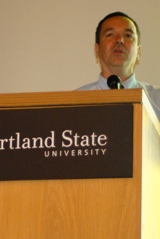
Carfree Cities Conference.
(Photos © J. Maus)
During his inspiring keynote speech at the Carfree Conference yesterday, Gil Penalosa gave Portlanders a lot to think about.
Penalosa is the former Commissioner of Parks, Sport, and Recreation for the city of Bogota, Colombia. During his tenure, he transformed that city (population 7 million) by creating hundreds of acres of new parks, developing a connected network of greenways (linear parks) and bike paths, setting up an ambitious public transit system (utilizing Bus Rapid Transit) and establishing the “Ciclovia”, a carfree streets program adored by millions of Bogota residents each week (and by urban planners around the world).
Now Penalosa — whose brother (and former mayor of Bogota) Enrique I wrote about in 2006 — has reinvented himself as executive director of Walk and Bike for Life, a non-profit dedicated to inspiring cities around the world to improve their quality of life by becoming more people-friendly.
During his presentation Tuesday, Penalosa was clearly excited that the term “carfree” is now making regular headlines across America. Just yesterday, New York City announced an ambitious “Summer Streets” program that will close nearly seven miles of streets in downtown Manhattan to cars during three days in August.
Penalosa gave part of the credit for New York City’s carfree event to Portland:
“Portland has a lot to do with it. Because in New York they were thinking about it… they said, Portland is doing it, and Chicago’s doing it, so New York said, we’re going to do it ahead of them… but this is such a healthy competition.”
“The reality is that Portland is far from being great, you have to realize that.”
— Gil Penalosa
But even with more and more cities taking a hard look at their transportation planning these days, Penalosa said, “There is no doubt that we are not doing enough.” He laid out the challenge that lies ahead by saying that the U.S. will add 100 million more people in the next 35 years (equal to the combined population of our 24 largest cities).
He challenged the audience:
“We must not only improve existing cities, we must build great cities… This is a wonderful and historic challenge, but it’s a fantastic opportunity because never before and never after are we going to build so many communities for so many people, in such a short period of time.
Unfortunately most of them are not being built like they should, so we’ve got to get moving.”
He then asked, “What kind of cities are we going to build? How do we want to live?” and said, “a city is only a means to a way of life.”
Throughout his presentation, Penalosa stressed that creating livable cities is about “economic survival”:
“In an ever more globalized world, the best people can live anywhere in the world. So why would they live in Portland, and not in Seattle or New York or Copenhagen or Sao Paolo, or wherever?
The other day I met a university professor from Texas and he got an offer for another job at another university in a different state with 10% more salary and he didn’t even think about it. Then he got another offer for 12% more salary and again he didn’t think about it. Then he got an offer to work in Portland with the same salary, not one cent increase, and he was thinking about it.
That’s the magic of having great cities.”
Penalosa said how to attract and retain highly creative and educated people is “the challenge of any city,” and that, “A good city is not just about engineering, it’s much more akin to an art.”
And although he praised Portland, he also warned against becoming too complacent.
“Sometimes it’s really hard to go from good to great. Sometimes it’s easier to go from bad to great because when you are bad you are willing to take more risks and you are willing to try different things. When you are good you become complacent.”
Then, he just came out and said it: “The reality is that Portland is far from being great, you have to realize that.”
Referring to Portland’s recent Platinum award, Penalosa said he wished the League of American Bicyclists had an award that “no one would ever get… like one of those rabbits in a dog race.”
Building a great city, he said, “has to be a process of continuous improvement.”
Where can Portland improve? Penalosa said we need to look at who’s riding today.
He pointed out PDOT stats showing that two out of three cyclists are men and that, “in places where 20-30% of the people are riding, usually more than half are women.”
Penalosa also pointed out that in Portland, 70% of cyclists are 25-50 years old and that no area in the city has over 10% bike usage.
Then he asked,
“Does Portland want to play with the heavyweights or the lightweights? Does Portland want to stay as champion of the little league of soccer across North America? Or, does Portland want to be champion of the World Cup?”
How can Portland (and other cities) begin to compete with in the World Cup of Great Cities? Here’s a slide from Penalosa’s presentation that lists how to, “Go from thinking and saying, to DOING:”
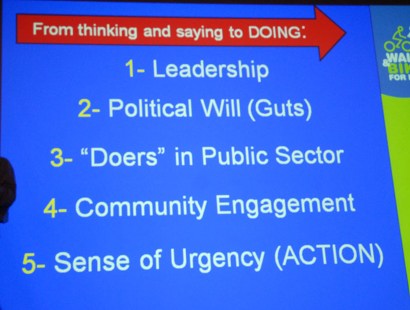
After his presentation, Penalosa (and League of American Bicyclists Director Andy Clarke, who also spoke yesterday) joined the media for a private press conference. I’ll post some video and thoughts from that later today.
I also recorded the audio from Penalosa’s presentation and, depending on quality and interest, I will post it here soon.
Visit the Carfree Conference page for more coverage or browse through the latest images in the Carfree Conference Photo Gallery.


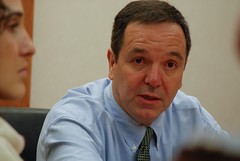
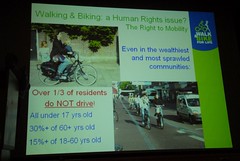
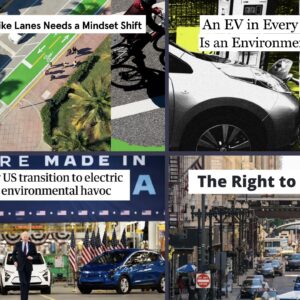


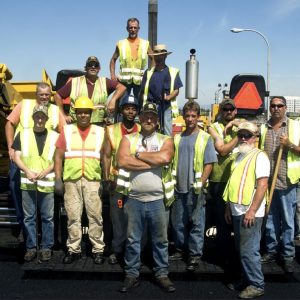
Thanks for reading.
BikePortland has served this community with independent community journalism since 2005. We rely on subscriptions from readers like you to survive. Your financial support is vital in keeping this valuable resource alive and well.
Please subscribe today to strengthen and expand our work.
If only Enrique could be our President.
Yeah, that would be great, but we are talking about Gil here (Enrique\’s brother.)
Wow. 100 million more Americans. What\’s the carbon footprint of that? Why don\’t environmentalists, planners, politicians ever talk about human over-population? It seems the root of so many problems. I guess the baby lobby and biology is just too strong…
Almost all of my allegedly \”green\” and socially aware friends have turned out to be breeders. And most of them drive much more and cycle much less as a result.
I wish I could\’ve been there…
I think examples like Bogota are very useful because it puts things into perspective: if a city in an impoverished third-world country, plagued by violence and civil war, can implement such ambitious urban planning, imagine what a wealthy and hyper-liberal city like PDX could (and should) do.
And since we are at it, we may bring up the example of another third world city, where I was born and raised: Curitiba, in Brazil, was where the BRT was originally invented. One cool thing that they did there was to turn a big portion of downtown streets into pedestrian only – something that could easily be reproduced here in Portland…
I\’d love to hear the audio. Thanks for covering this!
Great recap Jonathan of what was indeed a very inspiring keynote.
Penalosa did an excellent job showing the audience what sets a great bike & walk-friendly city apart from just a good one, talking about \”complete streets\” (more than just painted bike lanes), the human rights aspect of cycling and walking for transportation, recurring car-free days, and our duty to enable walking and biking as a mode of \”Recreation for ALL\”.
Amazing coverage Jonathan! You\’ve managed to capture the essence of Gil\’s speech in such a short summary. Impressive. Thanks for all you do.
Inspiring speech, no doubt. Seems like we have 3 of the 5 required points ready to go. It will be interesting to see how city leaders respond to Gil\’s gaunlet.
Maybe this is the wrong place but does anyone know if Trimet has or is exploring anything like a BRT?
If you read Jonathan\’s awesome article here on BikePortland, without then going **straight** to this website to watch the astounding video short on Bogota, Columbia\’s weekly Ciclovia, where they close 70 miles of streets to cars, and get around 1.8 million people out walking, biking, skating, taking dance classes in street etc… I will cry!
http://www.streetfilms.org/archives/ciclovia/
I echo everyone. Great job Jonathan!
Does anyone know if it\’s possible to obtain a copy of the slideshow? This would be great to publish if we can get Gil\’s permission.
Though I disagree that the American population will increase that much. The difficult economy is already reducing births and this trend is likely to continue.
During my stint at TriMet, there was a small faction across departments who would advocate for BRT over more MAX–but didn\’t find much traction (no pun intended). Not sure why.
I\’d love to hear the audio.
And I agree with his point about the Platinum – nice that we\’re top of the current heap, but this heap ain\’t too high. There\’s so much more to be done!
#3, I\’ve wondered the same thing about over-population. On a political level there\’s a pretty ancient motivation for societies, and sub-sects of societies to encourage their citizens to be as prolific as possible. That\’s the kind of thing that has a lot of momentum, even in these days of (for the first world anyway) low infant mortality. This momentum takes many different forms, like tax laws that favor breeding, and mild stigmas associated with not having kids.
Jonathan has done a great job summarizing Gil\’s speech, but what no print summary can do is catch the warmth and personality and presence of this man. He clearly gets it in a way that most elected and appointed officials do not, and he does not shy one bit from saying what needs to be done. The sheer beauty of his presentation style is that he encourages you to be better, and that even when he\’s listing all the areas in which you need to improve, you never feel like he\’s putting you down, belittling your accomplishments, or discouraging you in any way. He has tremendous warmth and humor, and really brings home his points in a way that sticks with you.
I\’d love to have officials with Gil\’s speaking style in Portland government, and in our advocacy organizations.
Aaron (#10) – the American population will likely continue increasing in the short term – native-born population increase has been flat to declining for a couple of decades, US population increase is almost entirely through immigration – until the opportunities in the US are fewer than in most other countries, immigration will likely continue to be a major factor in our population growth rate.
Overpopulation is a much-ignored problem in all countries, in part because it is almost impossible to address fairly, and ties into our most basic drive to live.
Equally a problem (and in the short-term more so) is the issue of inequitable use – i.e. the fact that the US, with 5% of the world\’s population uses 25% of the world\’s resources. That means every new person in the US (whether born or immigrated) is equal to 5 births in the theoretical \”average\” world country. In practice, one American is equal to dozens or hundreds of new births in Africa, parts of Asia, or parts of South America.
This is one reason why it\’s so crucial to get people walking and on bikes and transit – we HAVE to get the use of resources down. Conserving and curtailing one\’s shopping helps too.
Those are unpopular ideas in the US, though – remember what Dick said: \”The American way of life is non-negotiable\”.
(Cheney, not Nixon – though \”Tricky Dick\” might have said the same at one time)
Mr. Penalosa\’s talk was incredibly inspiring. He kept asking, \”Should we be building cities for cars or for people? Which kind of city would you want to live in?\” His perspective on transportation, livability, and overall city form was beautiful; as he went through and discussed different streets (especially before and after shots of \”incomplete\” streets that only had car lanes but were later \”completed\” once transit, pedestrians, and bicycles were accommodated), the choice to structure our cities for people first and cars second seemed like a no-brainer. I\’m so glad that he came to speak.
\”two out of three cyclists are men and that, “in places where 20-30% of the people are riding, usually more than half are women.\”\”
I recently got my girlfriend into cycling, and she\’s at the point now where she\’s not only comfortable with cars, being on her own, fixing a flat, etc, she\’s hooked. Since I work out of town we don\’t get to ride together much, but she told me last weekend about something I\’d never thought about. Apparently she\’s been cat-called, harassed, and even followed riding alone now, and is a little intimidated. I know this is slightly off-topic, but is this an American culture thing? How much of this maybe factors into a reason why 70-80% of the riders are male? Does this occur in Europe and Latin America too, or even much in Portland (she lives in a rural area, which may explain a lot)?
Great article Jonathon!
You forgot to mention that here in Portland were doing our very first \”Cilcovia\” this Sunday on N. Portland where 6 miles of street will be shut down to cars. Here is the info:
http://www.portlandonline.com/transportation/index.cfm?c=46103
If there is a large tournout, the City of Portland is more likely to do it again.
Please attend! It\’s going to be fun!
\”but what no print summary can do is catch the warmth and personality and presence of this man.\”
Matt,
I completely agree and i\’ve been thinking about that. I plan to share more from Penalosa.. including my thoughts, video, and audio… all of which I hope will help people understand that warmth and sincerity you mentioned.
\”He laid out the challenge that lies ahead by saying that the U.S. will add 100 million more people in the next 35 years\”
Environmentalists and livability types, allow me to introduce you to the pink elephant in the room. His name is Exponential Population Growth.
When my father was born, there were less than two billion people on this planet. By the time he dies (assuming average life expectancy) there will be more than seven billion people on the planet. By the time I die, assuming we avoid catastrophe, There will be just under nine billion people living on earth.
You just can\’t talk about sustainability without talking about population growth, but it seems like it\’s mentioned mostly as it is here as an inevitable aside for which to plan, because it seems impossible to stop. If we don\’t do more than plan around it, or technology really does save us, mother nature will solve the problem eventually and it won\’t be pretty.
It is so Great to have Gil Penalosa give a keynote right here in my city! His message is spot on.
Some things about BRT that I have learned during my work at Metro TPAC.
BRT has been looked at in almost every corridor, and is not truly off the table anywhere mostly. But BRT has many disadvantages compared to rail.
The regional \”High Capacity Transit\” studies and plans are just kicking off, and BRT is an option in most of the corridors.
BRT has a lower capital (startup and construction) cost than Light Rail. Which is one of the things that make it very popular in discussions…
However, BRT also has a fairly significant higher operating cost (especially with diesel fuel costs rising dramatically).
BRT also, to be effective capacity wise, usually requires articulated busses. Articulated busses are not well suited for most of Portland\’s streets – but they could work on a few routes. Specifically a BRT route would include major modifications to right of way – which would be made for the size of the busses.
BRT also is not as socially popular. Now I know that I will hear groans and all of that, but hear me out on this one. Part of a successful transit system is making one that people will WANT to ride. One that will get people out of their cars. And for some reason, probably purely psychological, Light Rail is much more attractive to those potential riders than busses and BRT. Right or wrong, good or bad – there are just thousands of potential riders that will consider streetcar or light rail but never ride a bus. Misplaced preference for sure, but one that does exist.
But if and when BRT ever pencils out there is nothing really stopping Portland from possibly having a BRT system to augment other places.
One thing that has always puzzled me is why we don\’t make our light rail tracks ALSO bus express ways. For example, the tunnel on the west side. It should have been built to allow express busses to ALSO use it and skip traffic on 26. Busses can use the light rail right of way, and then hop off to get into neighborhoods… This would add more \”capacity\” to the light rail tracks, while reducing transit time to many neighborhoods and reducing over-all impact of traffic on the system.
In any event, back to the topic at hand.
Absolutely Portland has lots of work to do. In fact, on 1190 KEX this morning there was a lot of discussion about how the car free Sunday Parkways was going to hurt businesses and cause traffic congestion. ? ? ?
And we still have elected leaders talking about building the massive CRC project (while at the same time they seem to want to reduce carbon emissions?).
We have areas in the suburbs where bicycle infrastructure and transit are almost non-existent – forcing people to rely only on cars. (It is easy to look at inner Portland and think all is rosy when forgetting what it can be like in the suburbs and outer areas. Just try getting from Oregon City or even Lake Oswego to Hillsboro or Gresham without a car in any sort of efficient manner).
We have huge areas of Southwest Portland that want sidewalks and bike access but due to extremely complex terrain it will cost millions and millions to build it. (It is very hard and expensive to expand roads to add bike lanes and sidewalks when there are so many steep hills and creeks and bridges). I wonder if $4.2 billion dollars could build bike paths, bike lanes, and sidewalks for all of Southwest Portland and get all of those people some real options for non-car transportation…
We have an aging elderly population that does not live near a fixed transit route, and thus relies on extremely expensive (to the taxpayers) LIFT service.
We have blue-collar workers who work schedules when transit does not run, at places which have no bicycle infrastructure and who are priced out of the close in transportation friendly residential neighborhoods.
There is certainly a lot of work to do. And as far as Bicycles go – we really need to focus on getting that 60% of interested but nervous riders out there and on their bikes. We really need to focus on providing REAL alternatives to the car. Not forcing people out of cars – but giving real alternatives that are practical and reliable.
Portland is ahead of many places – but Mr. Penalosa is exactly right – we need to work very hard to keep getting better.
We HAVE to put pressure on our elected officials. And anyone who read this far down in the comments is already most likely involved – so we have to keep up the good work.
The opening scene of Idiocracy explains the population problem the best…
\”One thing that has always puzzled me is why we don\’t make our light rail tracks ALSO bus express ways.\” John Reinhold
A wider tunnel to allow lanes for buses too? Or a bus undercarriage equipped with rail wheels like some track service trucks have? Doesn\’t sound practical.
I am certainly glad that I was able to attend this inspiring keynote speech.
Maybe we could have him head our Parks department. That would be impressive.
I\’m lucky to live in Toronto only bacause that has awarded me the opportunity to listen to Gil on more than one occasion; he lives in Mississauga which is right beside Toronto.
Gil is right.
While the rest of us look to Portland for inspiration for our own cities, we have to be setting the bar higher still. Portland is a good city to show that it is possible to change a North American city for the better, and that cycling needs to be part of this transformation.
During the launch of our Bike Union in May we let Gil have the last word. His comments were not too dissimilar to what you heard. Baby steps are not enough. Bold actions are required.
Just simply paving the tunnel floor just like tracks at grade in the city. So that busses can drive on it too. Like the streetcar tracks, or the tracks around the rose garden and other places.
Put the \”lane miles\” without traffic congestion to use to help out the bus network too.
No special equipped busses, just trackways that can be driven on as well.
Think of having an express bus that could avoid traffic and then turn off and go into a neighborhood or alternate corridor and serve the stops there. It would be like a hybrid of Light-Rail, BRT, express bus service, and neighborhood bus service – all utilizing lane miles that have 10 minutes between trains that are unused.
The only thing would be there would need to be some paved \”pull outs\” and some other mechanism to prevent mechanical problems on a bus from clogging the rail line.
But we have really smart engineers, they could make something like this work…
The reason why Gil highlighted the BRT system in Bogota is that, like the original in Curitiba, it works really really great. These systems move a LOT of people. Great cities (the kind he challenged us to become) are choosing to build them for good reason. I recently rode the new BRT line on Avenida de los Insurgentes in Mexico City. It is rapid transit. The stations have turnstiles and the buses come every 2 minutes. Operator costs may be more than for trains, but more operators is a good thing: The MAX system is now perceived (probably rightly) as sketchy and unsafe after a seemingly unending series of attacks that would probably not have occured on buses with operators present, or turnstiled platforms. As for diesel costs: look to Seattle, Vancouver BC or San Francisco with their electric trolley buses. No reason BRT couldn\’t use articulated trolley buses.
Also, it is false logic to say that North Americans want sexy trains rather than BRT, because in fact there basically IS NO BRT yet in North America with which to make this comparison. And whether a transit vehicle has rubber tires or not is ultimately not germane. The subway trains in Mexico City (a really great system by the way) have rubber tires. They are also 10 cars long, run at high speeds, and arrive every 2 minutes. We need systems that work. BRT is proven.
John Reinhold, thanks for clarifying what you were thinking of. It\’s probably more complicated to do that than it sounds; two tractions surfaces with mutually dependent compatibility that has to be sustained(and buses are hard on road surfaces it seems), but it\’s an interesting idea.
I guess what I don\’t like about BRT, is that, from what I\’ve heard, these buses to date, are almost entirely dependent on diesel or gas to run them. If the lanes these vehicles ran in had electric wires that could be used to power hybrid buses, that would be a better idea to my mind.
You know, one of the aspects that has made BRT so efficient (at least in the case of Curitiba) was not only the articulated buses and the exclusive lanes. Actually, the most important element is the system itself: one in which there are many categories of buses, each fulfilling one task but coordinated with the others in the system as a whole.
For instance, in Curitiba there are buses who run only in the neighborhoods, \”collecting\” people and bringing them to the main stations where they can hop into the big, articuladed buses that run with few stops up and down the city in different directions. Then you have the buses that run trough different neighborhoods, making a circle around downtown but never getting into downtown itself. And so on. Each of this categories of buses have different collors, but always on a single fare.
This Integrated system (as they call it there), logistically planned, is the most important part for an efficient Public Transportation system.
In my opinion, Portland should do this but adding bikes to the equation, doing the role that in Curitiba certain categories of buses do. So, for example, the city could create in each part of town bike avenues that run towards the local major station, where they could hop in a Bus (or train) that brings them to other parts of town.
The logistical integration is the most important part, though. But there seems to be a tendency here to isolate each element (perhaps because everything is driven by interest groups?)
Maybe this is a low blow, but I do have to find it ironic and funny when a Columbian says Portland “is far from being great” no matter what his pedigree. He hails from a city that has a fatal car bombing every few years, and a country that features a violent insurgency, paramilitaries, and national forces who recruit and deploy child soldiers.
I get the focus of his point, but nonetheless find it humorous. Call me a nationalist, but I\’ve been to Bogata, and it\’s far from being great.
What an inspiring man Gil Penelosa is, he has the warmth and understanding to get people thinking in a different direction. His speech was true in that Portland better not just settle down and concede to being the best bike city because this will make us become complacent and other cities will use there sense of urgency to catch up and then surpass Portland. It will and is coming fast so we need to keep the fire under our ass. Things are looking great for this world, cars just need to take a back seat to human interests. I recorded audio footage of this speech and will try to make it available soon.
Please post the audio! Even if the quality is poor, it\’s better than nothing.